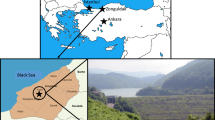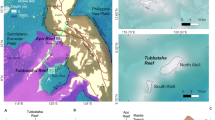Abstract
This paper deals with a finite element stability analysis performed on a sea-cliff affected by a deep notch. The cliff is about 200 m long with height ranging between 8 and 19 m. The notch at the cliff base is about 1 m above sea level, nearly stretching along the entire cliff toe. Detailed geo-structural and geo-mechanical surveys were performed in situ, and rock samples were tested in laboratory. The relevant physical and mechanical properties were used for determining rock mass strength parameters. A finite element approach was implemented using a two-dimensional elasto-plastic finite-element stress analysis program. The stability analysis shows that the notch causes increasing shear strains spreading from the notch end towards the top cliff. Decreasing strength reduction factors affect the cliff as the notch reaches increased depth into the rock mass, and when its depth is about 2 m the analysis results do not converge. At this stage, an uninterrupted shear plane develops along which a roughly prismatic rock block can slide and then topple.














Similar content being viewed by others
References
Bandis S, Lumsden AC, Barton NR (1983) Fundamentals of rock joint deformation. Int J of Rock Mech Min Sci Geomech Abstr 20:249–268
Barton NR (1972) A model study of rock-joint deformation. Int J Rock Mech Min Sci 9:579–602
Barton NR, Choubey V (1977) The shear strength of rock joints in theory and practice. Rock Mech 10(1):1–54
Benumof BT, Strolazzi CD, Seymour RJ, Griggs GB (2000) The relationship between incident wave energy and sea cliff erosion rates; San Diego County, California. J Coastal Res 16(4):1162–1178
Budetta P, Galietta G, Santo A (2000) A methodology for the study of the relation between coastal cliff erosion and the mechanical strength of soils and rock masses. Eng Geol 56:243–256
Budetta P, Santo A, Vivenzio F (2008) Landslide hazard mapping along the coastline of the Cilento region (Italy) by means of a GIS-based parameter rating approach. Geomorphology 94:340–352
Cinque A, Romano P, Rosskopf C, Santangelo N, Santo A (1994) Morfologie costiere e depositi quaternari tra Agropoli e Ogliastro Marina (Cilento—Italia Meridionale). Il Quaternario 7(1):3–16 (In Italian)
Deere DU, Miller RP (1966) Engineering classification and index properties for intact rock. University of Illinois Urbana, Illinois. Technical report No. AFWL-TR-65-116, p 327
Duperret A, Genter A, Martinez A, Mortimore RN (2004) Coastal chalk cliff instability in NW France: role of lithology, fracture pattern and rainfall. In: Mortimore RN, Duperret A (eds) Coastal Chalk Cliff Instability. Geological Society, London, Engineering Geology Special Publications, vol 20, pp 33–55
Hampton MA (2002) Gravitational failure of sea cliffs in weakly lithified sediment. Environ Eng Geosci 8(3):175–191. doi:10.2113/8.3.175
Hoek E, Brown ET (1988) The Hoek-Brown failure criterion—a 1988 update. In: Curran JC (ed) Proceedings 15th Canadian rock mech symposium. Department Civil Engineering University of Toronto, pp 31–38
Hoek E, Wood D, Shah S (1992) A modified Hoek-Brown criterion for jointed rock masses. In: Hudson JA (ed) Proceedings rock character symposium. International Society Rock Mechanics: Eurock ‘92. British Geotechnical Society, pp 209–214
Hoek E, Marinos P, Benissi M (1998) Applicability of the geological strength index (GSI) classification for very weak and sheared rock masses. The case of the Athens schist formation. Bull Eng Geol Env 57(2):151–160
Hoek E, Carranza-Torres C, Corkum B (2002) The Hoek-Brown failure criterion—2002 edn. Proceedings 5th North American rock mechanics symposium and 17th tunnelling association of Canada conference, pp 267–271
Hutchinson JN (1972) Field and laboratory studies of a fall in upper chalk cliffs at Joss Bay, Isle of Thanet. Roscoe memorial symposium. Cambridge University, 1971. Henley-on-Thames; Foulds GT & Co. Ltd, pp 692–706
Intergovernmental Panel on Climate Change—IPCC (1997) An introduction to simple climate models used in the IPCC second assessment report. In: Houghton JT, Meira Filho LG, Griggs DJ, Maskell K (eds) IPCC technical paper 2th—IPCC, Geneva, Switzerland, pp 51. http://www.ipcc.ch/
International Society of Rock Mechanics—ISRM (1978) Suggested methods for the quantitative description of discontinuities in rock masses. Int J of Rock Mech Min Sci & Geomech Abstr 15:319–368
Kanji MA, Galvàn VR (1998) Correlation of properties of soft rocks. In: Evangelista A, Picarelli L (eds) Proceedings 2th international symposium on hard soils-soft rocks, vol 1. Balkema, Rotterdam, pp 239–252
Kogure T, Aoki H, Maekado A, Hirose T, Matsukura Y (2006) Effect of the development of notches and tension cracks on instability of limestone coastal cliffs in the Ryukyus, Japan. Geomorphology 80(3–4):236–244
Ladanyi B, Archambault G (1977) Effect of block size on the shear behaviour of jointed rock. In: Proceedings of the 23th US symposium on rock mechanics. Berkeley, CA, pp 739–760
Lippmann-Provansal M (1987) L’Apennin campanien méridional (Italie). Etude géomorphologique. Thése de Doctorat d’Etat en Géographie Physique, Université d’Aix, Marseille
Marques FMSF (2008) Magnitude-frequency of sea cliff instabilities. Nat Hazards Earth Syst Sci 8:1161–1171
Mortimore RN, Lawrence J, Pope D, Duperret A, Genter A (2004) Coastal cliff geohazards in weak rock: the UK chalk cliffs of sussex. In: Mortimore RN, Duperret A (eds) 2004. Coastal chalk cliff instability. Geological society, London, engineering geology special publications, vol 20, pp 3–31
Quigley RM, Gelinas PJ, Bou WT, Packer RW (1977) Cyclic erosion instability relationships-Lake Erie north shore bluffs. Canadian Geotech J 14:310–323
Regione Campania—Autorità di Bacino Regionale Sinistra Sele (2006) Piano Stralcio Erosione Costiera. Relazione generale. http://www.adbsinistrasele.it/
Rocscience Inc. (2002) ROCLAB Rock mass strength analysis using the Generalized Hoek-Brown failure criterion. Toronto, Ontario, Canada. http://www.rocscience.com
Rocscience Inc. (2008) PHASE2 v 7.0 finite element analysis for excavations and slopes. Software tools for rock and soil—Verification manual. Toronto, Ontario, Canada. http://www.rocscience.com
Sunamura T (1992) Geomorphology of rocky coasts. Wiley, Chichester
United States Geological Survey (USGS) (2004) Formation, evolution, and stability of coastal cliffs—status and trends. Professional paper no 1693. In: Hampton MA, Griggs GB (eds). http://pubs.usgs.gov/pp/pp1693/
Wines DR, Lilly PA (2003) Estimates of rock joint shear strength in part of the Fimiston open pit operation in Western Australia. Int J of Rock Mech and Min Sci 40:929–937
Wyllie DC, Norrish NI (1996) Rock strength properties and their measurement. In: Turner AK, Schuster RL (eds) Special report 247: landslides investigation and mitigation, transportation research board. National Research Council, Washington, DC, pp 372–390
Acknowledgments
The author is grateful to Regional Agency “Autorità di Bacino Sinistra Sele” that provided topographical and photogrammetric surveys, and climatic data. The author is also grateful to Dr. Claudio De Luca and two anonymous referees for text review, valuable comments and suggestions that improved this paper. This work was carried out with financial contributions from the University of Naples “Federico II”, under Prof. P. Budetta.
Author information
Authors and Affiliations
Corresponding author
Rights and permissions
About this article
Cite this article
Budetta, P. Stability of an undercut sea-cliff along a Cilento coastal stretch (Campania, Southern Italy). Nat Hazards 56, 233–250 (2011). https://doi.org/10.1007/s11069-010-9565-y
Received:
Accepted:
Published:
Issue Date:
DOI: https://doi.org/10.1007/s11069-010-9565-y




